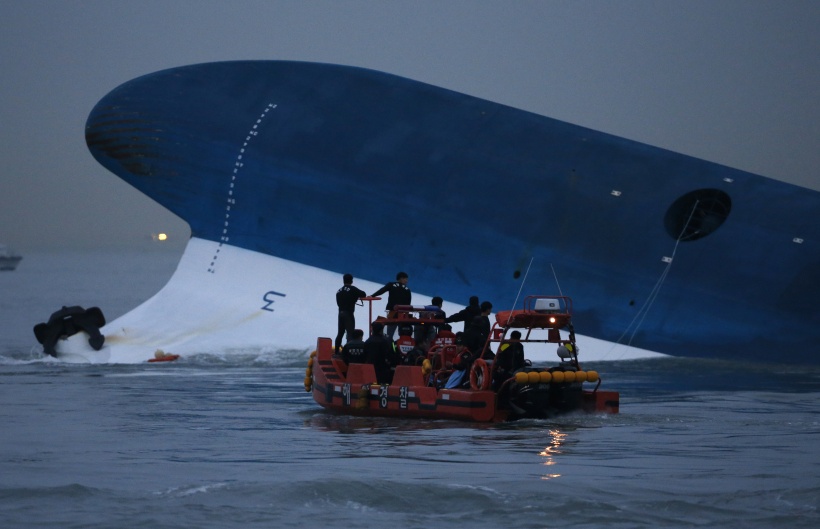The Sewol Disaster: 10 Tips From Korean Reporters
Korean reporters covering the Sewol ferry disaster faced challenges they were not prepared for. Here, they offer their advice and tips for colleagues on the lessons they learned, and the preparation they wish they had before facing coverage of such a tragedy. Click here to read Chong ae Lee's full report on Korea's national tragedy.

Dart Asia Pacific fellow and journalist Chong ae Lee spoke to Korean journalists who covered the Sewol ferry disaster. From those discussions, she compiled the following tips on covering such a disaster:
- Even in a breaking news situation, question and doubt every press release, even if it is generated by an official government agency or law enforcement body. Try to investigate their claims. This means that media organizations need more experienced senior journalists on the scene—not necessarily for live coverage but as investigative reporters. Also remember that in disaster reporting, being first means nothing if the report is not accurate.
- Disaster reporting guidelines must be adopted and training must take place ahead of time so journalists are prepared. Ethical issues related to trauma should be part of the disaster reporting guidelines, which can’t be learned while covering an incident.
- The reporter’s role is not only to inform people of what is happening but also to ensure that reporting is done as it should be. Reporters must listen to and give victims, survivors and families equal voice. Listen to what victims and their families want to say, if they are willing to say anything. Don’t just hear what you want to hear.
- Understand that victims and families have undergone great shock and may be suffering the effects of trauma. Be sensitive and careful so as to not do further harm. Don’t disturb people when they are in the throes of grieving. Be aware that they might be angry and distraught. Try to explain what you’re looking to do with them, and why it is important that they consider talking with you. Never misrepresent yourself or lie. Even if they do not grant permission for an interview, be as respectful and sincere as possible. It can be helpful to approach people without microphones or cameras to first build rapport and trust.
- Learn that sadness and other emotions can be conveyed even at a distance or via indirect shots. Getting too close to a mourning family is not always the most effective way to cover a disaster. The CNN Report of the Sewol ferry disaster was a good example of how sad stories can be told from a respectful distance.
- Do not try to trigger further emotions in victims, families or the general public. The reason to report is not just to provoke people but to provide them information, help them cope with the situation and find ways to prevent similar incidents. Repeatedly showing angry and hurt families does not help anyone.
- Reporters covering a traumatic incident should check in with each other about how they are doing, and encourage one another to talk about why what they’re doing is important and make sure that they know they are not alone. Senior journalists, who have encountered a variety of traumatic incidents, should also look after colleagues so they know they have someone that they can talk to if things become too difficult. Most reporters are affected in one way or another by trauma, and peer support is the best proven method of help.
- If a lot of journalists approaching victims and families seem to do more harm than good, try to organize a pool system. Families’ emotional trauma is not something to compete over. Some reporters felt that if a senior reporter had said: “Don’t force the families to talk. We don’t need their interview just to show they are in pain,” then they would have conducted themselves differently and families would have trusted them more. When the Ansan Danwon high school reopened and the third year students went back to school, SBS decided not to use long distance shots of students but to use drawings instead, which was as effective as the real images. Develop a wise way to approach trauma.
- In the digital age, there can be all different lengths of interviews. Many families were upset when they had been interviewed for 10 minutes and the news only showed 10-20 seconds. To gain trust, JTBC (the cable TV station owned by the JoongAng Ilbo newspaper) started to present longer interviews. Even if longer interviews can’t be used on television, extended interviews could be shown online and families might feel that their voices are at least being heard, and their stories respected.
- If anger and distrust toward reporters is acute, one reporter suggested trying to connect with families on a more human level and offering an apology. One reporter said that the first thing she did when she returned to Jindo was to visit families and sincerely apologize for what many reporters had been doing wrong. She said she told them she was not there to report but to try to explain. She said that much that had gone wrong was unintended, and was often due to lack of experience and poor decisions, and she was sorry if it had contributed to their pain. Afterwards some families were willing to open up to her a bit more which helped her recovery process as well. Some newspaper companies also apologized in their newspapers for what they had done wrong in reporting on the Sewol ferry disaster, and the National Union of Media Workers representing 63 media companies with a total of 5,623 journalists also offered an apology. All of these apologies were an effort to gain back trust.

































































































